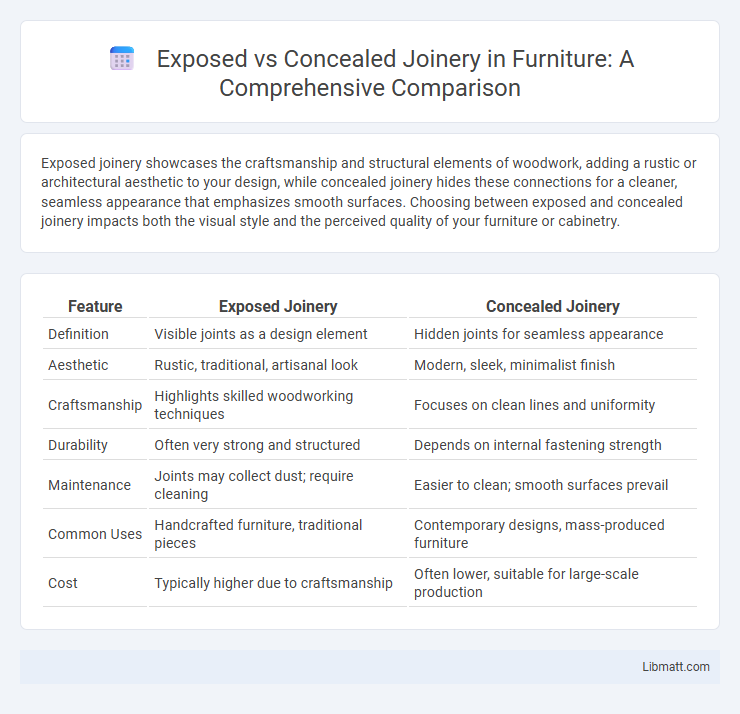Exposed joinery showcases the craftsmanship and structural elements of woodwork, adding a rustic or architectural aesthetic to your design, while concealed joinery hides these connections for a cleaner, seamless appearance that emphasizes smooth surfaces. Choosing between exposed and concealed joinery impacts both the visual style and the perceived quality of your furniture or cabinetry.
Table of Comparison
| Feature | Exposed Joinery | Concealed Joinery |
|---|---|---|
| Definition | Visible joints as a design element | Hidden joints for seamless appearance |
| Aesthetic | Rustic, traditional, artisanal look | Modern, sleek, minimalist finish |
| Craftsmanship | Highlights skilled woodworking techniques | Focuses on clean lines and uniformity |
| Durability | Often very strong and structured | Depends on internal fastening strength |
| Maintenance | Joints may collect dust; require cleaning | Easier to clean; smooth surfaces prevail |
| Common Uses | Handcrafted furniture, traditional pieces | Contemporary designs, mass-produced furniture |
| Cost | Typically higher due to craftsmanship | Often lower, suitable for large-scale production |
Introduction to Joinery Techniques
Exposed joinery showcases the craftsmanship of wood connections with visible joints like dovetail or mortise and tenon, emphasizing aesthetic appeal and structural integrity. Concealed joinery hides these connections within the wood, creating a sleek, seamless appearance while maintaining strength through methods such as dowels or biscuits. Your choice between these techniques influences the visual style and durability of furniture or woodworking projects.
Defining Exposed Joinery
Exposed joinery refers to woodworking joints intentionally left visible as a design feature, showcasing craftsmanship and structural integrity in furniture and cabinetry. Types of exposed joinery include dovetail, mortise and tenon, and finger joints, each adding aesthetic appeal and strength. This technique highlights the natural beauty of the wood and the skill of the joiner, often becoming a hallmark of quality in handcrafted pieces.
Defining Concealed Joinery
Concealed joinery refers to construction techniques where the connections between materials are hidden from view, enhancing the aesthetic appeal by maintaining clean, seamless surfaces. This method often employs dowels, biscuits, or hidden fasteners embedded within the wood to ensure stability without visible hardware. Concealed joinery is ideal for modern furniture and cabinetry where a sleek, uninterrupted design is desired.
Aesthetic Considerations
Exposed joinery showcases craftsmanship through visible joints like dovetails or mortise and tenon, adding character and a rustic or traditional aesthetic to furniture and cabinetry. Concealed joinery hides connections within the structure, resulting in clean, seamless surfaces that suit modern, minimalist designs emphasizing simplicity and sleek lines. Your choice between exposed and concealed joinery will significantly impact the visual appeal and style coherence of your woodworking project.
Structural Strength and Durability
Exposed joinery offers superior structural strength by allowing craftsmen to use robust, interlocking techniques such as dovetail and mortise-and-tenon joints, which distribute stress evenly and enhance durability. Concealed joinery, while providing a cleaner aesthetic, often relies on adhesives, dowels, or fasteners that may not support the same load capacity over time, potentially compromising long-term stability. Woodworking projects prioritizing longevity and mechanical strength typically favor exposed joinery for its proven resilience and resistance to wear.
Installation and Craftsmanship
Exposed joinery requires precise craftsmanship to ensure joints are both structurally sound and aesthetically appealing, often showcasing intricate woodworking techniques like dovetails or mortise-and-tenon. Installation of exposed joinery demands careful alignment and finishing, as the joints are visible and imperfections can detract from the overall design. Concealed joinery simplifies installation by hiding connections within the structure, allowing for cleaner surfaces and faster assembly, but still relies on skillful craftsmanship to maintain strength and durability.
Cost Comparisons
Exposed joinery typically incurs higher costs due to the precision and craftsmanship required to create visible joints that enhance aesthetic appeal, often involving intricate cuts and high-quality materials. Concealed joinery generally reduces labor expenses and material waste by hiding joints, allowing for faster assembly and simpler construction techniques. When budgeting for woodworking projects, the choice between exposed and concealed joinery directly impacts overall costs, with exposed joinery favoring premium finishes and concealed joinery providing cost-effective durability.
Popular Applications and Uses
Exposed joinery is popular in rustic furniture, cabinetry, and timber framing where craftsmanship and structural elements are highlighted for aesthetic appeal. Concealed joinery is widely used in modern furniture, kitchen installations, and high-end cabinetry to achieve a seamless, minimalist look while maintaining structural integrity. Both techniques serve functional and decorative purposes, chosen based on design style and visual emphasis.
Maintenance and Longevity
Exposed joinery allows for easier inspection and maintenance, making it simpler to detect wear, cracks, or separations early, which can extend the lifespan of the structure. Concealed joinery offers a cleaner aesthetic but may require more frequent professional inspections and specialized repairs, potentially increasing maintenance costs over time. Proper treatment and regular upkeep of both joinery types are crucial to ensuring long-term durability and structural integrity.
Choosing the Right Joinery for Your Project
Exposed joinery highlights craftsmanship with visible joints such as dovetails or mortise and tenon, adding aesthetic value to furniture or cabinetry. Concealed joinery offers a seamless, modern appearance by hiding joints within the structure, ideal for minimalist designs or when surface smoothness is essential. Selecting the right joinery depends on project style, durability requirements, and whether the joinery itself is a design feature or intended to remain discreet.
Exposed Joinery vs Concealed Joinery Infographic

 libmatt.com
libmatt.com